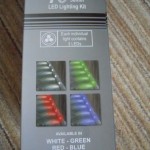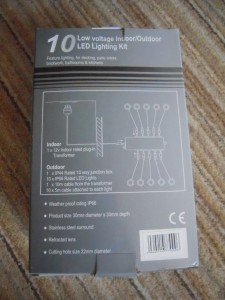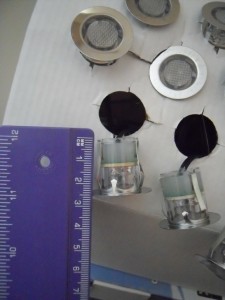Auxillary Battery Selection
Best to start with what I want in the van, then we can discuss loading and ultimately battery selection.
Lighting
| The LED’s – very bright, and designed for decking / Kitchen plinths etc.
I have a box of blue and a box of white. I doubt I’ll be using all of the LED’s, but the intention is to split them up into groups. They will be replacing the standard light units in the roof and door wells. They will go down both sides of the roof. The plan is to have them switched either on with the doors, off, or on. The transformer is 240v input and 12v 230mA output. So the transformer is not required, but I will utilise the connector units (I have one per set – see pic 2) where possible. |
|||
|
|
|||
Laptop
Not use it all the time, but it would be nice to run it.
240vAC input @ 2.5A. Output 19.5vDC @ 6.7A 130W
Drill Charger
Not use this a lot, but when away at sailing meetings, it may be required.
240vAC input @ 1.0A. Output 5-12vdc @ 2.8A (51W).
Mobile Phone Charger
iPhone – what more needs to be said. It needs charging. 240vAC 0.2mA. Or the DC cig socket lead – I pressume this is of similar rating?
Coolbox / Fridge
These take juice. I’m err’ing on the side of caution with 12vDC cig socket @ 1.0A. I stuck a meter in the fuse holder and recorded 0.9A.
Tunes
Then I thought that I may want to listen to the radio whilst parked up. And this leads to another problem. Whilst I’ve been working on the van I’ve listened to the radio. All be it for 4 or so hours, never the less, the main battery drained enough to not let me start her up again. So do / should I divert the main supply of the radio to the Leisure battery, whilst keeping the memory on the main battery – in case I isolate and remove the leisure bat?
I’ll have to look at the paperwork in the loft for this, or look at the stickers on the units. With the pop up screen, well, popped up, this will have an effect on the current rating. Also the Sat Nav is a seperate Din unit located under the seat. This is also on.
Calculations
The load for the auxillary circuit is not great. A few lights, coolbox / fridge, maybe the laptop for a little while, Most probably not (did you hear that Mrs L?) a hair dryer – well not whilst the van isn’t plugged into the mains!
The battery I opted for is a 110AH lead acid leisure battery. It says maintenance free, but I’ll take that with a pinch of salt. 110AH may seem big, but I think this is the biggest one around that will fit into the space I have allocated for it. Lets have a break down of our loads and see how long our 110AH battery will last.
| 2 Sets of LEDs @ 230mA / Set = | 0.460A |
| Laptop (input to the transformer) = | 2.500A |
| Battery Drill Charger (1A input / 2.8A output) = | 1.000A |
| Mobile Phone Charger = | 0.200A |
| Coolbox (runs off of cig socket) = (Measured current as 0.9A) |
1.000A |
| Pioneer Sat Nav Radio (with lcd screen off) = | 1.000A |
| Total = (Rounded Up) |
6.200A |
There is a complication with the laptop and battery drill charger…… The Inverter. This adds other complications / additional loads to the system.
So ideal world, the battery will last:
(110AmpereHours / 6.2Amps) = 17.7 Hours.
BUT, assuming the battery is 100% charged, it has only a useful life until it gets down to about 40% remaining charge. Also, if a battery is run down past 50% regularly, it is unlikely you will fully recharge it again. So allowing for this:
27.5 Hours -40% = 10.6 Hours
Ouch! 10.5 hours constant with all things blazing. BUT as mentioned, the laptop would rarely be used, same for the battery drill charger, but we need to calculate for the worst case scenario. So taking them off to see what a normal weekend away would be, we get:
(110AH / 3A) – 40% = 22 hours
But, yes, another but…. At 6.2Amps being drawn, the battery will discharge faster than if 3Amps are drawn. Now I’m not complicating things, I am just highlighting the facts. Much greater detail about Peukerts Equation here… http://www.smartgauge.co.uk/peukert2.html
But we’ve calculated the time with everything on and in theory with a good condition battery, 10 hours will be more than enough for a weekend away. When away, do you really want to spend your time sat in the van on the laptop? Honestly? You sad person you!


